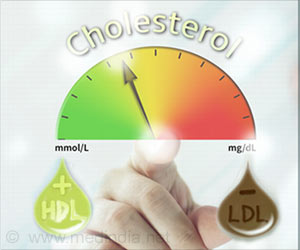Many stroke patients have cholesterol higher than national guidelines recommend that, if managed, may have prevented the stroke from happening.
Many stroke patients have cholesterol higher than national guidelines recommend that, if managed, may have prevented the stroke from happening, according to a study published in the issue of Neurology, the scientific journal of the American Academy of Neurology.
The study of 1,040 people hospitalized for stroke or transient ischemic attack (TIA) found that 27 percent had cholesterol higher than recommended by national guidelines. TIA happens when blood flow to part of the brain is reduced for a short period of time, but then returns, resulting in temporary neurological symptoms.“If this high cholesterol had been recognized and the guidelines been followed, then 93 percent of these people would have been treated with cholesterol-lowering drugs,” said Eric E. Smith, MD, MPH, with the Massachusetts General Hospital Stroke Service in Boston, and a member of the American Academy of Neurology. “Studies have shown that these drugs reduce the risk of stroke, so it’s probable that, if the guidelines had been followed, at least some of these strokes and TIAs would never have happened.”
Even people who had previously been diagnosed with high cholesterol and those who were already taking cholesterol-lowering drugs were not at their ideal cholesterol level according to the guidelines. Thirty percent of those previously diagnosed with high cholesterol and 19 percent of those taking cholesterol drugs were not at their ideal cholesterol level. The ideal cholesterol level is determined based on an individual’s risk of stroke or heart disease.
“Unfortunately, we found that the people who were at the greatest risk for a stroke or heart attack were also the least likely to be at the guideline-recommended cholesterol levels,” Smith said.
The results indicate that cholesterol levels should be tested in anyone hospitalized with a stroke or TIA, and any high levels should be treated, Smith said. “We can’t assume that people taking cholesterol drugs are at their ideal levels for preventing stroke and heart disease,” he said.
The study was based on guidelines published in 2001 by the National Cholesterol Education Program. The guidelines were modified in 2004 with even lower ideal cholesterol levels proposed as an option for people at high risk of cardiovascular disease.
Advertisement
The American Academy of Neurology, an association of more than 20,000 neurologists and neuroscience professionals, is dedicated to improving patient care through education and research. A neurologist is a doctor with specialized training in diagnosing, treating and managing disorders of the brain and nervous system such as stroke, Alzheimer’s disease, epilepsy, Parkinson’s disease, and multiple sclerosis.
Advertisement
SRM










